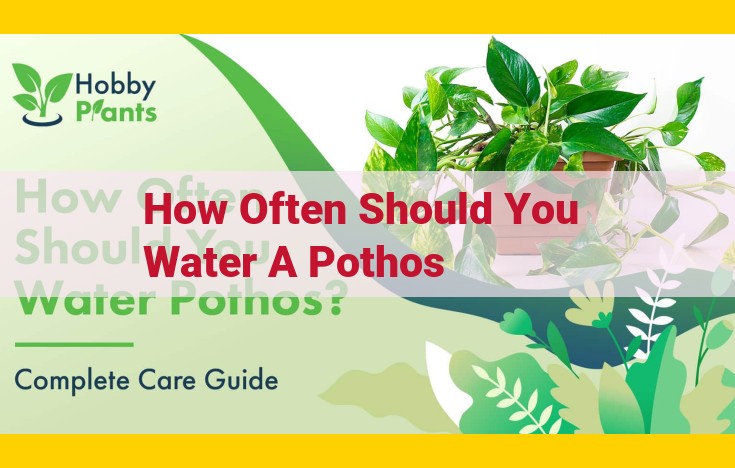Water your Pothos when the top 2-3 inches of soil feel dry to the touch. Adjust the watering frequency based on the pot’s size, ambient temperature, and humidity levels. Avoid overwatering by providing deep, infrequent watering sessions instead of frequent, shallow watering. Ensure your Pothos has proper drainage to prevent root rot.
Environmental Conditions: A Haven for Thriving Pothos
As you embark on the enchanting journey of nurturing a Pothos, understanding its environmental predilections is paramount. Let’s delve into the ideal habitat that fosters the well-being of this resilient plant.
Temperature: Pothos bask in warm environments, thriving between 65°F to 85°F (18°C to 29°C). This temperature range mimics their native tropical abode, providing optimal conditions for growth.
Humidity: Humidity is a crucial aspect of their environment. A humidity level of 40-60% aids in preventing leaf browning and crisping, creating a hydrated atmosphere for your Pothos to flourish.
Light: Pothos exhibit remarkable adaptability in terms of light conditions. They thrive in medium to bright indirect light, away from harsh, direct sunlight. They can also tolerate low-light environments, making them ideal for indoor settings.
Watering: Nurturing Your Pothos with the Right Hydration
When it comes to caring for your beloved Pothos, proper watering is paramount to its thriving health. Just like any living creature, your plant needs the right amount of liquid nourishment to flourish.
Establish a Structured Watering Schedule:
Customizing a watering schedule tailored to the specific needs of your Pothos is essential. Consider factors like its size, environment, and season. A larger plant will naturally require more frequent watering than a smaller one. Similarly, a Pothos placed in a warm, brightly lit room will need more frequent watering compared to one in a cooler, shaded area.
Importance of Soil Moisture Evaluation:
Before reaching for the watering can, it’s crucial to assess the moisture level of the soil. Insert your finger about two inches into the soil. If it feels dry to the touch, it’s time to give your Pothos a drink. Overwatering is a common mistake that can lead to root rot and other problems, so it’s always better to err on the side of caution.
Deep, Infrequent Watering:
When you do water your Pothos, make sure to do it thoroughly. Give the soil a generous soak until water begins to drain from the drainage holes at the bottom of the pot. This encourages the roots to grow deep and strong. Avoid frequent, shallow watering, as this can lead to root rot.
Room-Temperature Water and Avoiding Overwatering:
Always use room-temperature water for watering your Pothos. Cold water can shock the roots, while hot water can damage them. As mentioned earlier, overwatering is a major no-no for this plant. If you’re unsure whether it needs water, simply check the soil moisture. Remember, it’s always better to under-water than over-water.
Plant Health: Observing Signs of a Thriving Pothos
Maintaining the health of your Pothos plant is crucial for its well-being and vibrant growth. By monitoring your plant’s overall appearance and addressing any issues that arise, you can ensure that your Pothos thrives and brings joy to your space.
Observing Plant Growth and Decline:
Keep a close eye on your Pothos’s size, noting whether it’s growing steadily or declining. Healthy plants exhibit consistent growth, producing new leaves and vines regularly. Declining growth can indicate underlying issues, such as improper watering or lack of sunlight.
Addressing Common Issues:
Yellowing leaves are a common concern. This can be caused by overwatering, underwatering, or nutrient deficiencies. Adjust your watering schedule or fertilize your plant as needed. Wilting, on the other hand, can be caused by excessive heat, lack of moisture, or pests. Adjust the temperature, provide water, or treat for pests as necessary.
Preventing and Detecting Root Rot:
Root rot, a serious fungal disease, can occur due to poor drainage or overwatering. Symptoms include yellowing or brown leaves, wilting, and eventually plant death. To prevent root rot, ensure proper drainage by using a pot with drainage holes and avoiding waterlogging. Inspect your plant regularly for signs of root rot and take immediate action by repotting or trimming affected roots.
Water Retention: Striking the Balance for Pothos Happiness
When it comes to keeping your Pothos happy, finding the perfect balance in water retention is key. Achieving this balance can be tricky, but it’s the secret to preventing root rot and promoting healthy growth. Let’s explore the importance of proper drainage and the art of choosing the right potting mix for your Pothos.
The Vital Role of Drainage
Waterlogged soil is a Pothos’s worst enemy. It suffocates the roots and invites root rot, a deadly fungal disease. To prevent this, ensure your pot has drainage holes to allow excess water to escape. If there are no drainage holes, consider repotting your Pothos into a container that provides ample drainage.
Choosing the Right Potting Mix
The potting mix you choose also plays a crucial role in water retention. A well-draining mix allows water to pass through easily while still retaining some moisture to keep your Pothos hydrated. Look for a mix that combines organic matter, such as peat moss or compost, with inorganic materials like perlite or vermiculite. These ingredients provide both moisture retention and drainage.
Avoiding Waterlogging
While your Pothos needs moisture, too much water can be deadly. Overwatering can lead to waterlogged soil, creating the perfect conditions for root rot. Instead, water your Pothos only when the top inch or two of soil feels dry to the touch. When you do water, give it a thorough soaking until water comes out of the drainage holes.
Achieving water retention balance for your Pothos is essential for its thriving happiness. By providing proper drainage and choosing a well-draining potting mix, you can prevent root rot and keep your Pothos vibrant and flourishing.
